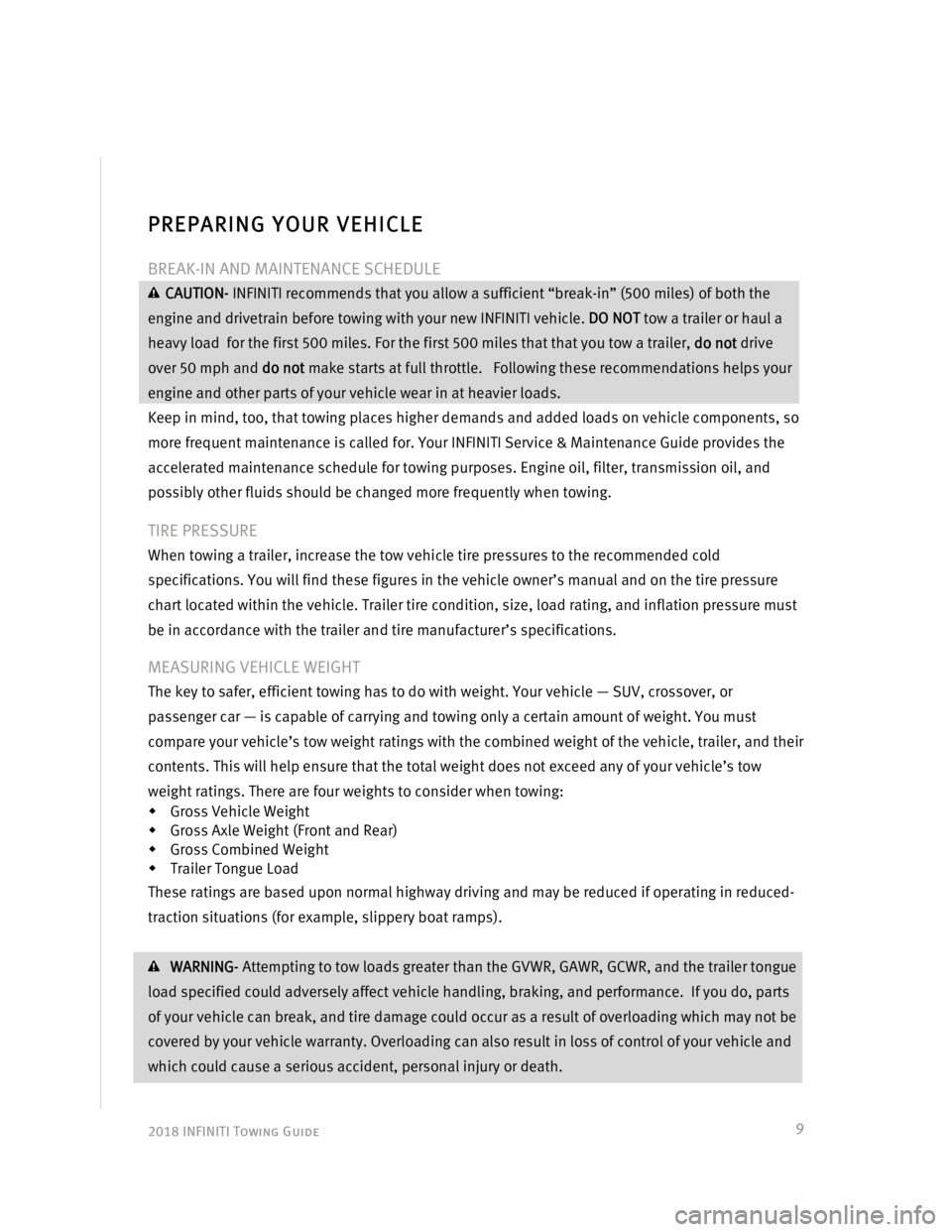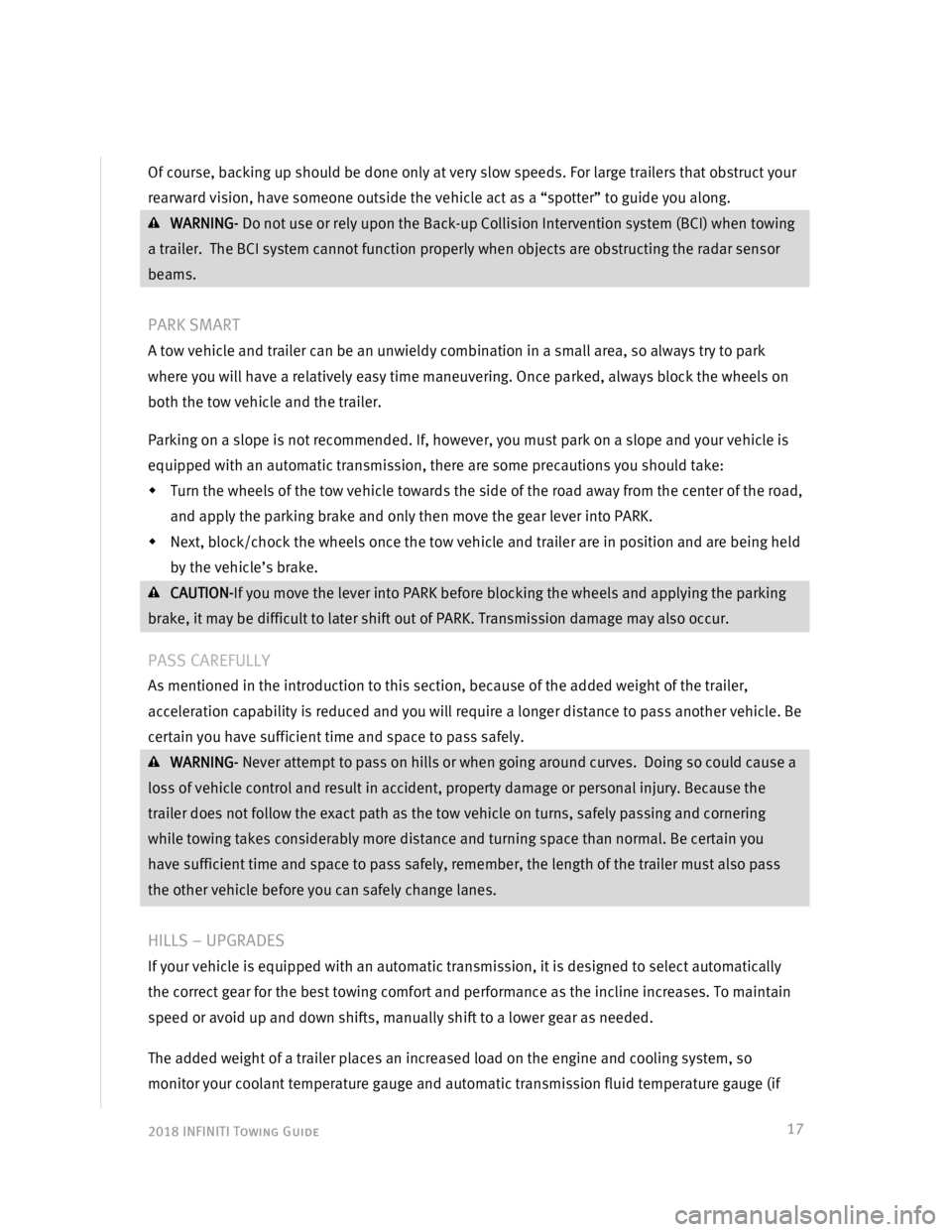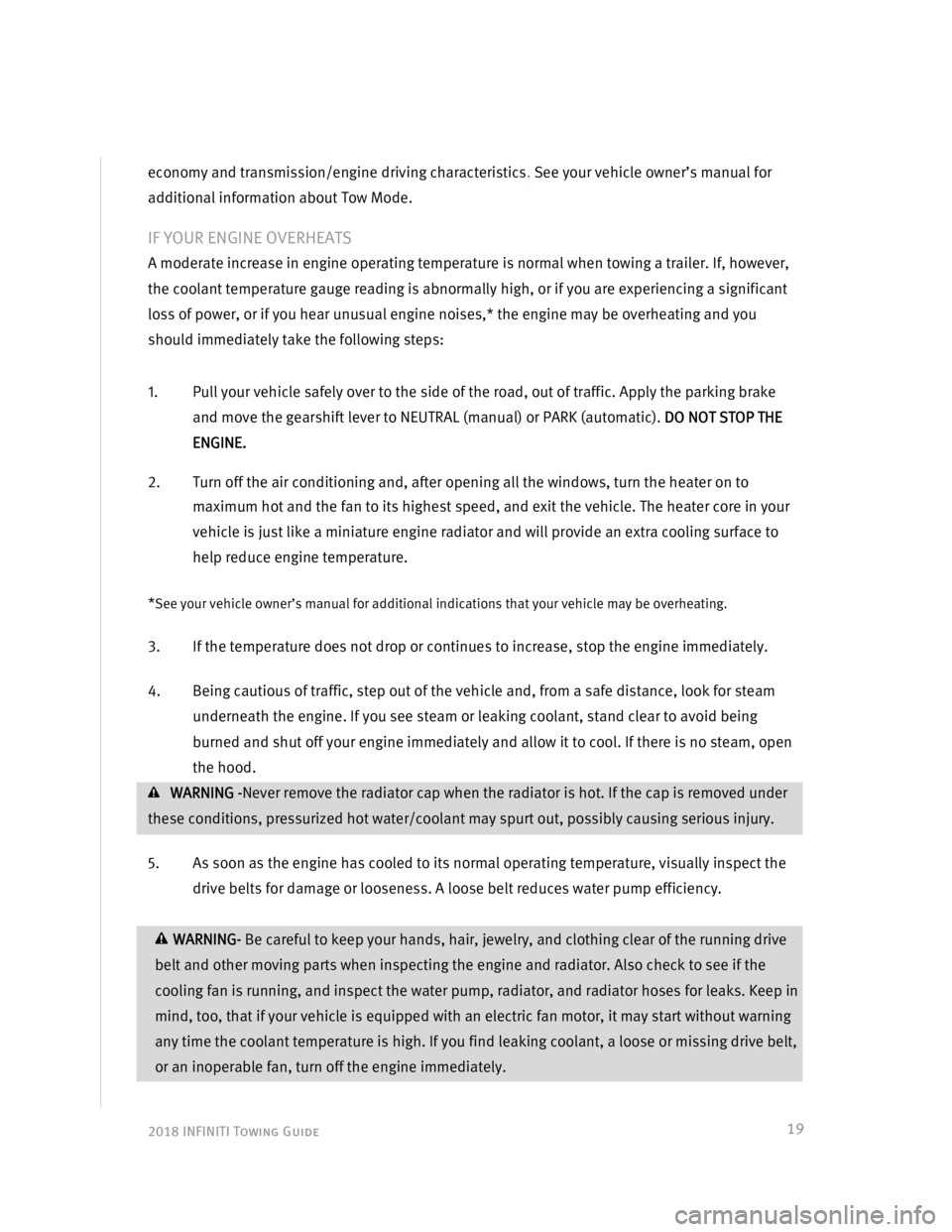manual transmission INFINITI QX30 2018 Towing Guide
[x] Cancel search | Manufacturer: INFINITI, Model Year: 2018, Model line: QX30, Model: INFINITI QX30 2018Pages: 25, PDF Size: 0.29 MB
Page 2 of 25

2018 INFINITI Towing Guide
1
SAFETY IS PRIORITY ONE
Obviously, your first concern should be safety. Your vehicle was designed to be used primarily to
carry passengers and cargo. Always remember that towing a trailer places additional loads on your
vehicle’s engine, drivetrain, suspension, steering, braking, and other systems. Therefore, be certain
that your vehicle can meet the demands of the towing application you have in mind.
Rent or purchase only the highest-quality towing and safety equipment you can find. Reinforced tow
hitches designed especially for certain INFINITI vehicles are available from your INFINITI retailer.
Hitches for other INFINITI models — if INFINITI recommends towing with that vehicle — should be
bought from and installed by a professional supplier of towing equipment. Carefully review all
information and literature provided with any hitch you purchase for safety and proper use
information. Finally, it is important to follow the towing capacity limit set for your specific vehicle
and to ensure that your vehicle is in top mechanical condition, especially the tires, brakes,
suspension, and engine cooling system. See your vehicle owner’s manual for details.
NEVER EXCEED THE ESTABLISHED TOWING CAPACITY
Towing capacities vary from vehicle to vehicle. See the towing information in your vehicle owner’s
manual to confirm whether your 2018 INFINITI vehicle can be used for towing and if so it’s towing
capacity .
EQUIP YOUR INFINITI FOR TOWING
The frequency and type of towing dictate the manner in which you equip your vehicle. If you plan to
tow often, either for recreation or work, select the engine size, transmission type, suspension, and
towing capacity that are best suited to your requirements. This guide can help you select the proper
equipment.
READ THIS GUIDE BEFORE YOU TOW
This guide was designed to provide an overview of safe towing practices. Here, you will find
information on towing equipment, safety, proper loading and driving techniques, towing tips, and
much more.
It is also a good idea to discuss your towing requirements with either your INFINITI retailer or a
professional supplier of towing equipment before you equip your INFINITI vehicle for towing.
Finally, there are state and local laws on towing that you should review to ensure compliance with
all regulations.
CAUTION: INFINITI recommends you do not use your new vehicle to tow a trailer or haul a heavy
load for the first 500 miles (800 km) of use. Your engine, axle or other parts could be damaged.
For the first 500 miles that you tow a trailer, do not drive over 50 mph and do not make starts at
full throttle. This helps your engine and other parts of your vehicle wear in at heavier loads.
INTRODUCTION
Page 10 of 25

2018 INFINITI Towing Guide
9
PREPARING YOUR VEHICLE
BREAK-IN AND MAINTENANCE SCHEDULE
CAUTION- INFINITI recommends that you allow a sufficient “break-in” (500 miles) of both the
engine and drivetrain before towing with your new INFINITI vehicle. DO NOT tow a trailer or haul a
heavy load for the first 500 miles. For the first 500 miles that that you tow a trailer, do not drive
over 50 mph and do not make starts at full throttle. Following these recommendations helps your
engine and other parts of your vehicle wear in at heavier loads.
Keep in mind, too, that towing places higher demands and added loads on vehicle components, so
more frequent maintenance is called for. Your INFINITI Service & Maintenance Guide provides the
accelerated maintenance schedule for towing purposes. Engine oil, filter, transmission oil, and
possibly other fluids should be changed more frequently when towing.
TIRE PRESSURE
When towing a trailer, increase the tow vehicle tire pressures to the recommended cold
specifications. You will find these figures in the vehicle owner’s manual and on the tire pressure
chart located within the vehicle. Trailer tire condition, size, load rating, and inflation pressure must
be in accordance with the trailer and tire manufacturer’s specifications.
MEASURING VEHICLE WEIGHT
The key to safer, efficient towing has to do with weight. Your vehicle — SUV, crossover, or
passenger car — is capable of carrying and towing only a certain amount of weight. You must
compare your vehicle’s tow weight ratings with the combined weight of the vehicle, trailer, and their
contents. This will help ensure that the total weight does not exceed any of your vehicle’s tow
weight ratings. There are four weights to consider when towing:
Gross Vehicle Weight
Gross Axle Weight (Front and Rear)
Gross Combined Weight
Trailer Tongue Load
These ratings are based upon normal highway driving and may be reduced if operating in reduced-
traction situations (for example, slippery boat ramps).
WARNING- Attempting to tow loads greater than the GVWR, GAWR, GCWR, and the trailer tongue
load specified could adversely affect vehicle handling, braking, and performance. If you do, parts
of your vehicle can break, and tire damage could occur as a result of overloading which may not be
covered by your vehicle warranty. Overloading can also result in loss of control of your vehicle and
which could cause a serious accident, personal injury or death.
Page 18 of 25

2018 INFINITI Towing Guide
17
Of course, backing up should be done only at very slow speeds. For large trailers that obstruct your
rearward vision, have someone outside the vehicle act as a “spotter” to guide you along.
WARNING- Do not use or rely upon the Back-up Collision Intervention system (BCI) when towing
a trailer. The BCI system cannot function properly when objects are obstructing the radar sensor
beams.
PARK SMART
A tow vehicle and trailer can be an unwieldy combination in a small area, so always try to park
where you will have a relatively easy time maneuvering. Once parked, always block the wheels on
both the tow vehicle and the trailer.
Parking on a slope is not recommended. If, however, you must park on a slope and your vehicle is
equipped with an automatic transmission, there are some precautions you should take:
Turn the wheels of the tow vehicle towards the side of the road away from the center of the road,
and apply the parking brake and only then move the gear lever into PARK.
Next, block/chock the wheels once the tow vehicle and trailer are in position and are being held
by the vehicle’s brake.
CAUTION-If you move the lever into PARK before blocking the wheels and applying the parking
brake, it may be difficult to later shift out of PARK. Transmission damage may also occur.
PASS CAREFULLY
As mentioned in the introduction to this section, because of the added weight of the trailer,
acceleration capability is reduced and you will require a longer distance to pass another vehicle. Be
certain you have sufficient time and space to pass safely.
WARNING- Never attempt to pass on hills or when going around curves. Doing so could cause a
loss of vehicle control and result in accident, property damage or personal injury. Because the
trailer does not follow the exact path as the tow vehicle on turns, safely passing and cornering
while towing takes considerably more distance and turning space than normal. Be certain you
have sufficient time and space to pass safely, remember, the length of the trailer must also pass
the other vehicle before you can safely change lanes.
HILLS – UPGRADES
If your vehicle is equipped with an automatic transmission, it is designed to select automatically
the correct gear for the best towing comfort and performance as the incline increases. To maintain
speed or avoid up and down shifts, manually shift to a lower gear as needed.
The added weight of a trailer places an increased load on the engine and cooling system, so
monitor your coolant temperature gauge and automatic transmission fluid temperature gauge (if
Page 20 of 25

2018 INFINITI Towing Guide
19
economy and transmission/engine driving characteristics. See your vehicle owner’s manual for
additional information about Tow Mode.
IF YOUR ENGINE OVERHEATS
A moderate increase in engine operating temperature is normal when towing a trailer. If, however,
the coolant temperature gauge reading is abnormally high, or if you are experiencing a significant
loss of power, or if you hear unusual engine noises,* the engine may be overheating and you
should immediately take the following steps:
1. Pull your vehicle safely over to the side of the road, out of traffic. Apply the parking brake
and move the gearshift lever to NEUTRAL (manual) or PARK (automatic). DO NOT STOP THE
ENGINE.
2. Turn off the air conditioning and, after opening all the windows, turn the heater on to
maximum hot and the fan to its highest speed, and exit the vehicle. The heater core in your
vehicle is just like a miniature engine radiator and will provide an extra cooling surface to
help reduce engine temperature.
*
See your vehicle owner’s manual for additional indications that your vehicle may be overheating.
3.
If the temperature does not drop or continues to increase, stop the engine immediately.
4. Being cautious of traffic, step out of the vehicle and, from a safe distance, look for steam
underneath the engine. If you see steam or leaking coolant, stand clear to avoid being
burned and shut off your engine immediately and allow it to cool. If there is no steam, open
the hood.
WARNING -Never remove the radiator cap when the radiator is hot. If the cap is removed under
these conditions, pressurized hot water/coolant may spurt out, possibly causing serious injury.
5. As soon as the engine has cooled to its normal operating temperature, visually inspect the
drive belts for damage or looseness. A loose belt reduces water pump efficiency.
WARNING- Be careful to keep your hands, hair, jewelry, and clothing clear of the running drive
belt and other moving parts when inspecting the engine and radiator. Also check to see if the
cooling fan is running, and inspect the water pump, radiator, and radiator hoses for leaks. Keep in
mind, too, that if your vehicle is equipped with an electric fan motor, it may start without warning
any time the coolant temperature is high. If you find leaking coolant, a loose or missing drive belt,
or an inoperable fan, turn off the engine immediately.